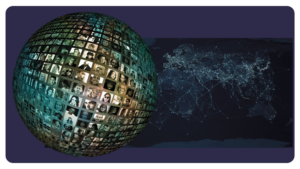Marketing Data
Motionworks® Primer Series: Synthetic Populations
Machine learning and artificial intelligence are valuable techniques to speed up processes, lower costs, and provide more accurate solutions. In addition, they provide better insights to inform businesses and improve infrastructure in industry verticals such as urban planning, retail, finance, real estate, advertising, marketing, autonomous vehicles, and travel and tourism.
The amount of data required to train these models properly is massive. In order to overcome this obstacle, companies utilize “synthetic data.” By training models with synthetic data, companies are able to overcome challenges such as incomplete datasets, privacy issues, data cleansing, and more. Motionworks® uses a specific type of synthetic data to fuel its Population Intelligence – synthetic population data.
This primer will help you understand everything you need to know about Motionworks’® use of a synthetic population to generate mobility data.
Motionworks® has developed an innovative and cutting-edge approach to population intelligence, revolutionizing the way we harness data for insights. Central to our methodology is the strategic integration of a synthetic or digital population.
It’s important to note that the term “synthetic” may raise eyebrows, suggesting a sense of artificiality, but in reality, this couldn’t be further from the truth. Let’s explore.
What is a Synthetic Population?
A synthetic population, also known as a digital population, is a duplicate of the real population often generated by machine learning or artificial intelligence (AI).

The incorporation of synthetic data stands as a legitimate and often-used technique, garnering widespread adoption and implementation across diverse industry verticals. From optimizing pivotal business decisions to enhancing urban infrastructure, fortifying financial safeguards, fostering improved health outcomes, and more. Synthetic data has emerged as an indispensable tool driving progress in the world of research and analytics.
In today’s dynamic landscape, where companies often their research solutions as comprehensive portrayals of the total population, the truth is that representing the complete spectrum of society in a responsible and accurate manner presents formidable challenges. Even in the unlikely scenario that a business was to acquire all the deterministic mobile data accessible in the United States, it would still represent a mere fraction of the movement of the total population.
By artfully interweaving real-world data with a meticulously crafted synthetic population database, Motionworks ®transcends the limitations of conventional approaches. Through the synergy of real-world and synthetic data, we chart a course towards a more nuanced and profound understanding of human mobility and behaviors without the need for skirting ethical issues and privacy regulations.
How is a Synthetic Population Developed?

In order to create a synthetic population, Motionworks® takes the information that it knows about each census block group – such as the demographics and distribution of the people who live there. Then, using artificial intelligence, Motionworks® creates a fully representative model of the total population. The synthetic population looks like the real population in all the ways that are important to Motionworks®, including age, income, ethnicity, gender, and how many people live in each dwelling.
The concept of a synthetic population may seem a bit confusing, but it is very similar to what is happening in some of the most common consumer-focused artificial intelligence applications today.
Many people are familiar with online art generators that are powered by AI, such as Nightcafe.
In order to create these applications, AI models are fed countless images of artwork that were created by real humans. After rounds and rounds of machine learning, the AI gets better and better at creating its own synthetic artwork, and eventually, it is nearly impossible to tell the difference between the synthetic art created by AI and the art created by humans.
A simple prompt of “a beautiful sunset in autumn” generates a piece of art that contains all of the elements of a sunset in autumn, the sky, trees with amber leaves, clouds – but it was synthetically generated. This is very similar to the way a synthetic population is created. A synthetic population looks, feels, moves, and behaves just like the real population.
Synthetic Population in Action: An Example

Imagine that a city wants to understand what will happen to the traffic flow if adds toll booths every two miles on the highway. Rather than building the toll booths and then dealing with real life repercussions, the toll booths can be “built” in a simulated environment.
Since the synthetic population still needs to get to work on time and pick up the kids after school, they will still go about their day, but will encounter the synthetic toll booths, which will then impact how long it takes them to get to their destinations. The simulated people may opt to take an alternate routes or leave earlier in the morning. Their may be traffic jams, slow-downs, an influx of traffic on bridges and tunnels, or increased traffic on residential streets. The impact of this many tolls in such proximity, would undoubtedly have an impact on the flow of traffic throughout the city as well as the drain on the city’s infrastructure.
Utilizing a synthetic population, the city is able to understand the impact of the tolls without ever having to build a single booth. In fact, the city can test multiple permutations of installations – varying the count and distance of toll booth installations and can use the insights generated to make better infrastructure decisions on behalf of its residents.
Motionworks® utilizes its Synthetic Population to help predict real world outcomes when hypothetical changes are made to the way people move about their day. These changes may be toll booth installations such as those discussed above, or may involve situations such as emergency city evacuations, double of the population in a geography, building a new shopping center, or installing public transportation options. We call this “Futurecasting.”
The Advantages of Using a Synthetic Population

There are many important reasons that Motionworks® utilizes a synthetic population as a core part of its methodology including:
Privacy.
Motionworks® is committed to providing insights in an anonymized, aggregated, and privacy-compliant way across all of our solutions. Motionworks® data does not provide insights into individual behaviors and cannot be reverse-engineered or manipulated to provide such information. Utilizing synthetic populations to understand population behavior is recognized as a process that preserves the confidentiality of individuals while providing realistic, representative data outputs.
Total Population Metrics.
The Motionworks® approach is developed to measure everyone, everywhere, all the time, rather than measuring device activity within a target polygon. There is no source of deterministic data available today that can provide persistent, accurate information on the location of every individual in the country. Only through the use of a synthetic population derived from a large deterministic data sample is total population measurement achievable.
Granularity.
The Motionworks® data set that is produced from this synthetic population reflects where everyone in the country is at any given moment in aggregation, allowing the data to be cut in a variety of ways and geographic resolutions while maintaining integrity.
How Synthetic Populations Are Validated
Motionworks® validates its Synthetic Population against multiple datasets in each geography. In the United States, it is validated against the US Census and Claritas Popfacts. In Canada, it’s validated against the Canadian Census and Environics Analytics. Our synthetic population aligns very closely with these datasets. More detailed information on our validation is available for the United States and Canada.
Key Use Cases of Synthetic Populations
It’s not just Motionworks® that uses synthetic population analytics. Many major companies are using this type of data to make better business decisions daily.
- Amazon uses synthetic data to train Alexa to better understand human language.
- Google’s Waymo uses synthetic data to train its self driving cars.
- Anthem Health improves its fraud detection technology and customer service utilizing a synthetic data set.
- American Express and JP Morgan both use synthetic financial data to train its system to better detect fraudulent transactions.
Marrying Synthetic Data with Real Data to Generate Population Intelligence
Our work does not stop with the generation of the Synthetic Population dataset, although many clients may find that database a worthwhile product on its own.
Motionworks® layers other datasets onto the Synthetic Population database to curate our Population Intelligence solutions. These include:
- Aggregated SDK data from multiple providers
- First-party SDK data
- Observed mobile data activity schedules from our curated, representative sample of millions of devices
- Connected car data
- National survey data
- Port of entry reports
- Our POI database
- Customers’ first-party data that provides:
- People counts
- Transaction counts
- Check-ins
- And more
Conclusion: Summarizing Motionworks’ Use of Synthetic Populations for Comprehensive Location Measurement
The use of synthetic data sets is growing in popularity across multiple industry verticals. In fact, Gartner predicted in the Wall Street Journal that “By 2024, 60% of the data used for the development of AI and analytics projects will be synthetically generated.”
Motionworks® stands as a beacon of privacy-conscious measurement. Our commitment to anonymized and aggregated insights that represent the full population, coupled with the pioneering use of AI to generate synthetic populations and population intelligence reshapes the mobility data landscape.
For more information about how Motionworks® utilizes synthetic populations and how we can put our insights to work for your business, please reach out to us at [email protected].

 Back
Back




